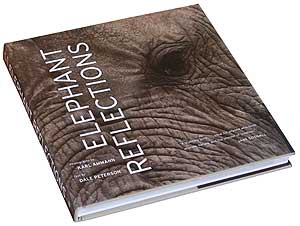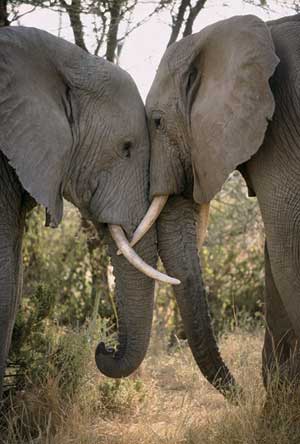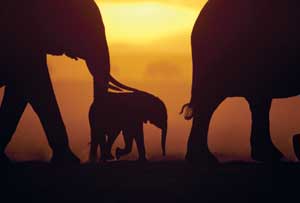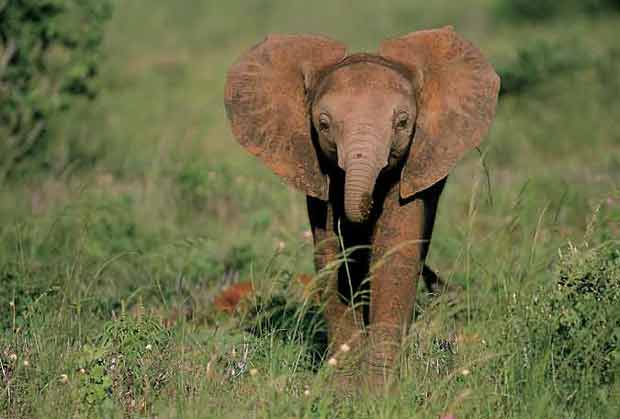Contact Details: Scotch Macaskill, Dirt Road Traders, Currys Post Road, Howick, KwaZulu-Natal, South Africa. Tel: +27 (0)82 578 2329. Privacy: Your privacy is guaranteed. See our Privacy Policy for more. This site accepts advertising and other forms of compensation - see Disclosure and Advertising for details. Site updated: 2022. Copyright © 2002 - 2022 Scotch Macaskill

| ||||||||||
|
||||||||||
|
SEE ALL
|
Elephant Reflections is a "Must-Read" Bookby Scotch MacaskillElephant Reflections by Karl Ammann and Dale Peterson, published in 2009 by the University of California Press, is a "must-read" book that will not only enhance your knowledge and understanding of elephants, but change the way you think about these remarkable animals. 
Cover Photograph © 2009 by Karl Ammann Meticulously researched, compiled with care and passion, and printed on high quality stock, Elephant Reflections is both a picture book and a word book, comprising about 130 color photographs by Ammann and 50 pages of text by Peterson. The "reflections" of the title refers both to Amman's photographs and Peterson's thoughts and insights. The book is a classic example of the whole being greater than the sum of its parts: the photographs have more impact when viewed after reading the text, while the words, particularly about elephant behavior and the way humans treat these animals, resonate with deeper meaning as one studies the images. My approach was to skim initially through the photographs to get a feel for the book, then read the text before returning to the images. Although the book is physically quite large - and heavy because of the paper quality - I was able to read it quite comfortably sitting in an arm chair. I mention this simply because some books of this style are so large and cumbersome that reading becomes an uncomfortable chore. Dale Peterson's words (or reflections) on elephants cover the following:

Elephants standing head to head in a friendly posture, Samburu, Kenya. Photograph © 2009 by Karl Ammann The research section makes riveting reading as we join pioneering elephant researchers like Iain Douglas-Hamilton, Cynthia Moss, Joyce Pool and Katie Payne in their often dangerous quest to find out more about the lives of African elephants, their social and family structures, migratory patterns, and mysterious methods of communication. It's amazing to think that by the late 1970s we knew much more about the moon's surface than we did about the mating habits of elephants! After the research section, Peterson explores how modern elephants evolved, from their unlikely ancestral links to sea cows and hyraxes, through the wooly mammoth phase, to the present day, where "they impress and, indeed, amaze us with their sheer improbability". Peterson then goes on to discuss in more detail the improbable physiology of our planet's biggest land mammals, including their large brains. From here it's a natural progression to elephant intelligence and reflections on animal emotions, particularly on how elephants react to the death of other elephants and, indeed, of other animals. Capable of Grief?Are elephants capable of grief, Peterson wonders, asking: "Are they aware of death?""That elephants feel various emotions is, I think, entirely clear", he writes. "They have bouts of anger or rage. They show signs of joy at being reunited with old friends or relatives, pleasure in companionship, maternal love, and other indications of positive attachment ..." Peterson provides many examples of elephant behavior that strongly imply emotional intelligence and a capacity for "feelings". It's a jolt after reading these intriguing accounts to face the unpleasant reality of how people treat elephants, how we routinely slaughter them for their ivory (their "front teeth") and, more recently, for their meat. Peterson's account of the ivory trade and elephant poaching is harrowing, particularly when one looks at the figures - in a period of 15 years, Kenya's elephant population dropped by 85% - from 170 000 to 25 000, meaning that six out of seven had been killed. It was only after Kenya's president, Daniel arap Moi, appointed renowned paleontologist Richard Leakey as director of the country's Department of Wildlife and Conservation Management in 1989 that the elephant slaughter slowed. Kenya Burns its Ivory StockpileWith President Moi's support, Leakey famously burnt Kenya's stockpile of ivory, valued at several million dollars, and helped persuade CITES to place African elephants on the Appendix 1 list in 1989, which meant a total international ban on all trading in ivory. This immediately brought a stop to ivory purchases and a virtual halt to elephant poaching, with only 55 elephants shot by poachers in 1990, the first year of the ban. Unfortunately, at least for the elephants, there is a great deal of politics involved, with southern African countries opposed to a total ivory ban. I live in South Africa, one of the countries where a burgeoning elephant population is seen as a conservation threat, so am aware of the conflicting opinions, particularly on the highly emotive and controversial issue of elephant culling. This is a subject that is regularly canvassed and debated in South Africa, with highly qualified scientists and researchers either supporting or opposing culling, so the answers are by no means clear-cut. Gripping NarrativeOverall, Peterson provides a fascinating, absorbing, and ultimately gripping narrative that's likely to change the way readers of the book think and feel about elephants. One can but hope that his words have a similar impact on some of those in power who are able to influence the way humans treat elephants.As mentioned earlier, the photographs have a greater impact after reading the text. It's worth noting that, unlike most books comprising photos and text, here the two are quite separate. While the first section of the book contains the photographs, with no captions or text, the second half carries the "story", but with no illustrative photographs. At the back of the book are thumbnails of the photographs with brief captions and comments. Whether this lay-out is entirely successful is debatable. I prefer photographs with informative captions. Similarly, the text to my mind would benefit from explanatory photos, maps and diagrams. Instead one is presented with about 50 big pages of double-column text with no chapter titles, sub-heads, or images - a sea of grey that some could find uninviting or intimidating. 
Elephants in silhouette against setting sun, Amboseli, Kenya. Photograph © 2009 by Karl Ammann Refreshingly DifferentOthers of course may well find the presentation refreshingly different from the norm, allowing the reader to linger over and absorb the photographs without distractions, while also being able to get their teeth into the written text. There is no question there are many outstanding photographs in the book, yet I'm left with a vague sense of disappointment. On one level photographing elephants is easy, simply because they're big and usually slow moving.
But to take exceptional elephant photographs is correspondingly difficult, for a variety of reasons, including:
So for Ammann - or any photographer for that matter - to produce more than 100 photographs, each one of which is somehow spectacular, is simply asking too much. And maybe that's what I was unfairly expecting - that every picture would make me go "Wow!" From a purely technical point, there is a softness about many of the images that disturbs me, although most people, particularly non-photographers, probably won't even notice. Nearly half the photographs are taken with an enormous 800mm lens, using 100 ISO Fuji Velvia film, so slight subject/camera movement is inevitable. (Compare today's digital SLRs from Nikon and Canon, capable of shooting virtually noise-free images at 400 or even 800 ISO - which is maybe what's causing raised expectations). Ammann prefers using film as he feels more secure storing his images as slides and one has to respect his point of view - no one knows as yet just how long digital storage devices like DVDs or hard-drives will last. The images have been sorted into themes, subjects, and genres. The themes, identified as Beginnings and Passages, are expressed in the opening and closing sets. The subjects include Textures, Colors, Perspectives, and Fragments, while the genres are those of portraiture (or Portraits) and action (Behaviors and Associations).
Nowadays I prefer wildlife pictures that show the animal in relation to its environment, so I'd like to have seen more of the "bigger pictures" - the Perspectives - rather than intimate close-ups produced with very long lenses. Having said that, make no mistake that many of the portraits and close-ups are breathtaking and will invoke a delighted "Wow!" from the viewer. But go see for yourself - buy the book (it's only $26 at Amazon), enjoy Dale Peterson's eminently readable, narrative-style text and then linger over Karl Ammann's intimate, often moving photographs. Then persuade others to buy the book, or at least lend them yours, and help spread the message of how vulnerable these massive, improbable, yet fragile animals really are. Disclosure: This book was provided for review, free of charge, by University of California Press. The opinions expressed above nevertheless represent the reviewer's honest opinion of the book. Return to Wildlife Articles |
|||||||||
|
|
||||||||||
